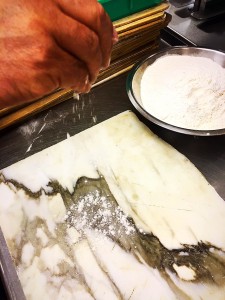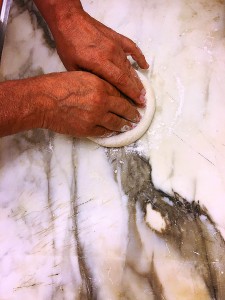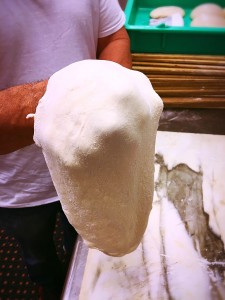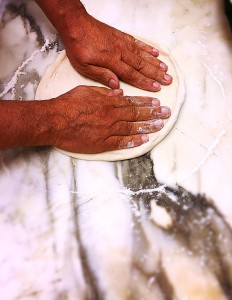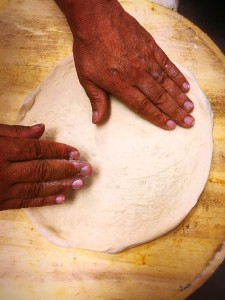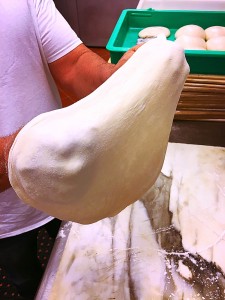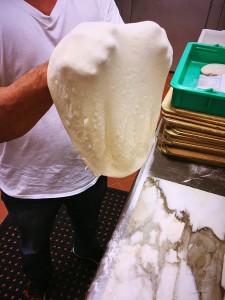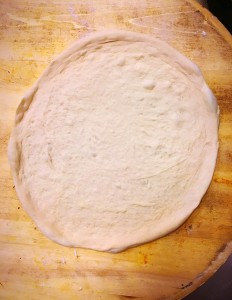Slight of Hand, Part One
Pizza a Mano — hand made pizza –– what is it that calls us to be pizza makers? Why would someone like Paulie Gee leave a career in computer technology to stand in front of a hot oven in Brooklyn? Why is a multi-talented entrepreneur like Tony Gemignani unable to keep his hands off any dough ball that crosses his path? I bet that at some point anyone who is reading this became hypnotized by the poetic motion of the hands of the pizza maker. It may have been watching your neighborhood pizza guy in the window of his shop when you were a kid. Maybe you caught the fever on a trip to Naples. Somewhere at some time you watched a pizza artisan and you thought, “I want to do that.” So, you gave it a try and, no matter what the result was, something magical happened. You became connected to a skill that has been handed down in an unbroken line for hundreds and maybe thousands of years. More than that, you became part of a continuum of sunlight, rain, soil, farmers, millers, suppliers, pizza makers and ultimately the end consumer. Something that you formed with your own hands became part of someone’s body.
Wow! That’s a big responsibility. One that cannot be taken lightly. This is why, in spite of modernization, people are still drawn to pizza making. It’s our job security and it’s why we will never be replaced by a machine. It’s also why I urge all beginning pizza makers to throw away their rolling pins. Nobody ever fell in love with a dough-sheeter or pizza press. Nobody watches someone feed dough into a machine and says, “I want to quit my job and do that.” Most importantly, a machine cannot replicate what we do by hand because a machine cannot constantly adjust to the subtle, ever changing conditions of a particular dough ball.
So, let’s get started on the basics of shaping a pizza by hand. The first step is preparing your mind; with pizza a mano it’s all about attitude. How you think about the task can greatly alter the result.
Remember, you are NOT flattening the dough (you could use a rolling pin for that). That is not your goal. You are extending the dough. What’s the difference? Only everything. A properly extended dough is full of life. It’s light, its airy, it’s tender, and it’s complex. A flattened dough is tough, dense, and devoid of character. Worst of all a flattened dough has had all of the C-O-2 squeezed out of it. Now, here is an important tip: Concentrate on feeling the trapped carbon dioxide moving within the structure of the dough. How you retain that gas and move it to where you want it to be will determine the cooking time, color, texture, flavor and of your finished pizza.
I strongly recommend that you work with warm dough (that is, room temperature) so, if you are using the cold fermentation method, be sure to take dough out of the cooler at least one hour before using. This will wake up the dough and get the yeast going to create a lighter crumb structure. It will also make your dough easier to extend. Always use a dough knife or scraper to remove dough from the box or fermentation container. We want to be sure not to deflate the dough or cause weak spots by tearing it out of the container. Champions like Nino Coniglio always use well-oiled individual aluminum cans to ferment and store dough so they can gently flip the dough on to the work surface without degassing it.
Here is a basic simple method of extending dough:
–Your work surface (preferably Italian marble) must be immaculately clean and dry. Rub the flats of your palms over it to feel for any sticking points. Be stingy with flour on the table and on the dough itself. Only use enough so that you can work the dough without sticking. Too much flour on the dough or the peel will make a mess of the oven causing soot on the pizza. If there is excessive flour on the dough itself it will mix with the water from your sauce and toppings to become paste that contributes to the hated gum line on poorly formed pizzas. Throwing a cloud of flour around is a special effect that show biz pizza makers like to use for drama. Skip it. Today we are making pizza for eating, not for watching.
–Hands off the cornicione. Never, and I mean never, let your hands compress the edge of the dough. Instead using your fingertips to press gas from the center of the dough towards the edge leaves a raised rim about the diameter of your pinky finger. Think of it like you’re blowing up a balloon. Move the air towards the edge and then seal it in by pressing down when you are a finger width from the edge. This indentation will become your sauce and topping line beyond which no ingredients shall ever dare to pass (more on that next month).
–Once you have established the cornicione, you can begin extending the dough by using the palms of your hands to gently shape the dough on the table. In fact, if you are using high hydration dough, all of the shaping will probably be done on the table. Train your hands to be sensitive to the peculiarities of each dough ball. Constantly feel for thin and thick spots. Smooth the dough with gentle pressure from your palms until both hands fit within the dough, which is now becoming a pizza. Be careful that you are not pressing too hard or compromising the rim. Now make a fist with one hand and drape the dough over it allowing the pizza to hang down over your knuckles. Place both fists close to the inner line of the cornicione with the pizza draping down. Your dough should be soft enough and warm enough that gravity will do most of the work. Do not force or muscle the dough. One fist should remain stationary. Your dominant hand will gently pull the dough a few inches and then return to touch your stationary hand. Do not cross hands. Simply separate hands and return while the dough hangs down in front of your fists. Within a few revolutions your pizza should be fully extended.
Next month we will explore
the methods of topping the pizza.
Remember, pizza making is a matter of individual preferences. There is no clearly defined right or wrong but every choice will have an effect on the finished product.
Key takeaway: Extend not only the pizza but also your knowledge, and you will have control of the result.




